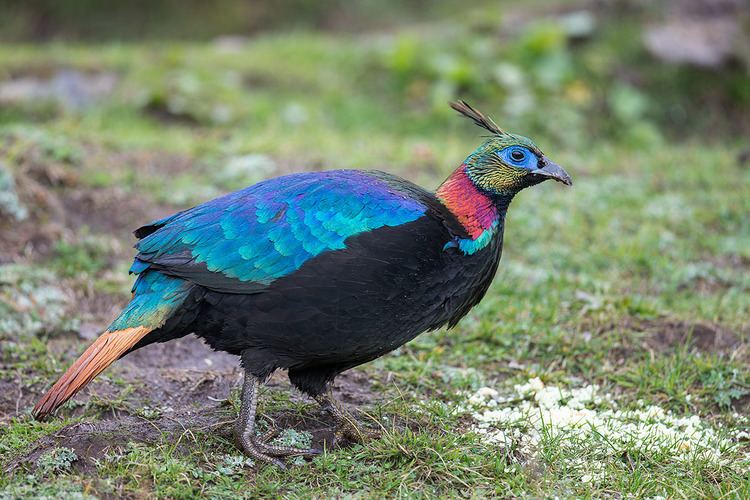Subfamily Phasianinae Scientific name Lophophorus impejanus Higher classification Monal | Genus Lophophorus Phylum Chordata Rank Species | |
Similar Monal, Bird, Tragopan, Satyr tragopan, Blood pheasant | ||
Hand feeding an himalayan monal male adult beautiful bird
The Himalayan monal (Lophophorus impejanus), also known as the Impeyan monal, Impeyan pheasant, is a bird in the pheasant family, Phasianidae. It is the national bird of Nepal, where it is known as Danphe, and state bird of Uttarakhand India, where it is known as Monal. It was also the state bird of Himachal Pradesh, until 2007. Traditionally, the Himalayan monal has been classified as monophyletic. However, studies have shown that the male Himalayan monal of northwestern India lacks the white rump of other Himalayan monals, and it has more green on the breast, indicating the possibility of a second subspecies.
Contents
- Hand feeding an himalayan monal male adult beautiful bird
- Himalayan monal male bird 1
- Description
- Distribution and habitat
- Conservation
- References

The scientific name commemorates Lady Mary Impey, the wife of the British chief justice of Bengal Sir Elijah Impey.

Himalayan monal male bird 1
Description

It is a relatively large-sized pheasant. The bird is about 70 centimeters long. The male weighs up to 2380 grams and the female 2150. The adult male has multicoloured plumage throughout, while the female, as in other pheasants, is dull in colour. Notable features in the male include a long, metallic green crest, coppery feathers on the back and neck, and a prominent white rump that is most visible when the bird is in flight. The tail feathers of the male are uniformly rufous, becoming darker towards the tips, whereas the lower tail coverts of females are white, barred with black and red. The female has a prominent white patch on the throat and a white strip on the tail. The first-year male and the juvenile resemble the female, but the first-year male is larger and the juvenile is less distinctly marked.
Distribution and habitat

The bird's natural range extends from eastern Afghanistan through the Himalayas in Pakistan, Kashmir region and India (states of Himachal Pradesh, Uttarakhand, Sikkim and Arunachal Pradesh), Nepal, southern Tibet, and Bhutan. There is also a report of its occurrence in Burma. It occupies upper temperate oak-conifer forests interspersed with open grassy slopes, cliffs and alpine meadows between 2400 and 4500 meters, where it is most common between 2700 and 3700 meters. It may descend to 2000 meters in the winter. It tolerates snow and will dig through it to obtain plant roots and invertebrate prey.

The breeding season is April through August, and they generally form pairs at this time. In winter they congregate in large coveys and roost communally.
Conservation
In some areas, the species is threatened due to poaching and other anthropogenic factors. In a recent study, the local population responded negatively to human disturbance involving hydroelectric power development. The male monal was under hunting pressure in Himachal Pradesh, where the crest feather was used to decorate men's hats, until 1982, when hunting was banned in the state.
In Pakistan the bird is most common in the Khyber Pakhtunkhwa province but it can also be found in Kaghan, Palas Valley, and Azad Kashmir. The pheasant is not considered endangered in the region and can be easily located. In some areas, the population density of the species is as high as five pairs per square mile. The main threat to the species is poaching, as the crest is valuable here, as well. It is thought to bring status to its wearer, and is a symbol of authority.
